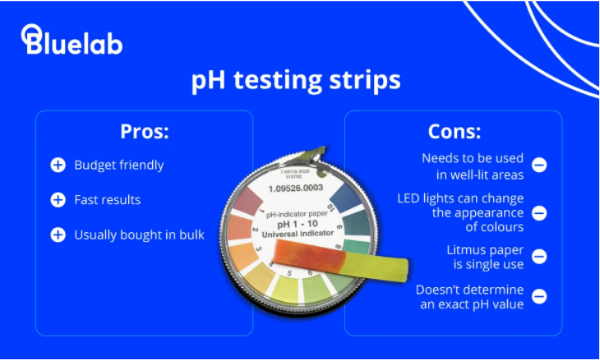For most growers, tending plants for pests and weeds is a common exercise that is usually done on a regular basis. But did you know that measuring the pH (potential Hydrogen) of your soil or hydroponic solution is just as important?
Measuring pH (potential Hydrogen) is important to help you maintain optimal nutrient availability to your plants, which ultimately supports healthier plant growth. If you’re serious about growing a healthy crop, pH should be one of the four plant health checks you should do daily.
%20(1)-png.png?width=532&name=Blog%20Blog%20Feature%20Image%20Narrow%20400x300%20%20(2)%20(1)-png.png)
Why measure the pH of soil or solution?
As a basis for plant growth, all plants need water and nutrients to grow and develop into healthy plants. The accessibility of these important nutrients for uptake is determined by the pH of their growing environment.
When we talk about pH, we are referring to the acidity (sourness) or alkalinity (sweetness) of your soil. Anything measured between 0-7 is considered acidic, 7 is neutral, and a range from 7-14 is alkaline.
The nutrient or element will have its preferred pH range to be fully dissolved and soluble. Only when they are in this state do they become available for uptake by your plants. When the nutrients are outside of their preferred pH range, they will be locked out from your plants which could lead your plants down the costly and time- consuming path of potential nutrient deficiency.
For growing, a general target soil pH of 6.5 is usually applied. There is a sweet spot for optimal nutrient availability which sits between pH 5.8 – 6.5 for hydroponics and 6.5 - 7.0 for soil.
Aside from maximising nutrient availability for your plants, certain plants will also have their own preference of pH environment. Some like a more acidic environment and some tending towards a more alkaline one.
The kite chart below shows how nutrient pH affects the availability of nutrients for your plants.
-png.png?width=662&name=Blog%20pH%20infographic%20663%20x%20900%20(1)-png.png)
How to measure the pH of growing mediums
Now we understand the “why” behind measuring pH for healthy plant growth, how do we go about putting this into practice?
The most commonly known method for measuring soil pH or nutrient solution is with pH testing strips. These work on a simple method of dipping the paper into a solution made from your soil sample. It will change colour according to the pH of your solution. This is then compared and matched to the manufacturer’s colour chart to determine the pH of your test sample.
The pros and cons of using pH testing strips
These pH test strips are accessible, simple to use and affordable. With that in mind, these little strips of paper seem like a pretty good option to go with to get those pH readings. But first, let’s explore a little further into the pros and cons of pH testing strips.
The pros of pH testing strips for growing
- Cost-effective
pH testing strips can be fairly cheap to buy, making them an affordable option for most.
- Fast results
The pH testing strips should immediately change colour to indicate the pH once it is dipped into your test sample solution. So you want your pH colour chart handy and be in a well-lit area to read your pH test strip.
The cons of pH testing strips for soil and solution
- Accuracy
Most pH test strips that are available for purchase are for general pH testing purposes, which means the paper will be for the purpose of testing the full pH range from 0-14. With the broad testable pH range, it does mean you won’t get an accurate reading.
- Single-use
pH testing strips are designed for single use only so you can not retest using the same one. A fresh new strip must be used each and every time you make a test measure. This is probably not really an issue if you are only doing the occasional pH test. However, if you are going to establish regular pH testing as part of your gardening monitoring routine, then you could potentially end up using quite a number of these pH test strips which start to add up in cost over time.
- Need good lighting
pH test strips do give immediate results which is great as you don’t want to be waiting around. You want to perform this test where there is good lighting to ensure you read the pH test strip accurately. As the results or readings are based on matching the test strips to a colour chart, the light environment you are in can affect the colour perceived. Not only the amount of light, but also the quality of light. Even other colours nearby can slightly alter the colour perception.
Digital pH meters
Now that we’ve looked at the pros and cons of pH testing strips, you are probably left wondering if there are any alternatives. You could always send your soil sample away for lab testing but not only is that expensive, it is also slow when you are wanting instant results. It’s not something you would want to be doing as part of your regular growing maintenance.
As a practical alternative, we would recommend considering a handheld digital pH meter. They work by submerging the probe into the nutrient solution to get an instant pH reading. As with the pH testing strips, they are also simple to use.
-png.png?width=663&name=Infographic%20600%20x%20360%20(1)-png.png)
pH testing strips do have a number of favourable features going for them and can work well if you just need an approximate pH range. However, if your budget allows for it and you are wanting to measure pH regularly with precise readings then handheld pH digital meters are a worthwhile investment.
Measuring your pH is important if your plants are showing signs of stress, or if you’d like to understand which plants might be best suited to your current growing environment. It’s not an easy task to change your soil pH, and it doesn't take much to over-fertilise and kill your plants. If you are struggling, it's easier and cheaper to switch to a container where you can control the soil type, or just change the crop to better suit your soil pH.
Bluelab does offer a pH meter plus a number of other different handy meters for measuring other fundamental parameters for optimum plant growth. You can find more about our handheld Bluelab soil pH pen and our Bluelab pH pen at our online store.
Further resources
Here are some handy resources to expand your understanding of pH.
Buyers guide: How to choose your plant health tools
The ultimate guide to pH, EC and temperature
A beginner's guide to measuring soil pH
Featured products:
Bluelab Multimedia pH Meter
Bluelab Soil pH Pen
Bluelab pH pen



%20(1).png?height=100&name=Blog%20Author%20Bio%20Image%20500x500%20(2)%20(1).png)



Submit a comment